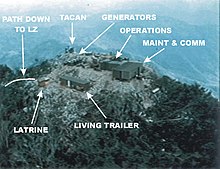Motorola SST-181 X Band Beacon Transponder

An AN/MSQ-77 at Lima Site 85
|
|
| Country of origin | United States |
|---|---|
| Type | Site area |
| Frequency | 8500 to 9600 MHz (X band) |
| PRF | 600 pulses/second or 300 pulses/secondTemplate:Due to Range Mode Switch, from 200K Yards to 400K Yards (range) |
| Pulsewidth | .25 microsecond |
| RPM | 30 cycles/second feedhorn rotation →20 pulses/cycle conical scan signal |
| Range |
200 nmi (370 km; 230 mi) beacon track 135 nmi (250 km; 155 mi) skin track 130 nmi (150 mi) UHF radio reliability |
| Diameter | 8 ft (2.4 m) Cassegrain antenna |
| Precision | tbd in range tbd degrees (radar track) tbd degrees (computer track w/ joystick alignment on CCTV image) GDB ACCURACY <680 ft CEP @ 200 nmi (specification) 486 ft CEP @ 44 nmi (1965 testing) 300-350 ft ave @ ≤100 nmi (1967 ops) |
The Reeves AN/MSQ-77 Bomb Directing Central, Radar (nickname "Miscue 77") was a USAF automatic tracking radar/computer system for command guidance of military aircraft during Vietnam War bomb runs at nighttime and during bad weather. Developed from the Reeves AN/MSQ-35, the AN/MSQ-77 reversed the process of Radar Bomb Scoring by continually estimating the bomb impact point before bomb release with a vacuum tube ballistic computer. Unlike "Course Directing Centrals" which guided aircraft to a predetermined release point, the AN/MSQ-77 algorithm continuously predicted bomb impact points during the radar track while the AN/MSQ-77's control commands adjusted the aircraft course. A close air support regulation prohibited AN/MSQ-77 Combat Skyspot bombing within 1,000 yd (910 m) of friendly forces unless authorized by a Forward Air Controller, and "on several occasions" strikes were as close as 273 yd (250 m).
Post-war the MSQ-77 was used on US and other training ranges for Radar Bomb Scoring (RBS). The AN/MSQ-77 was also periodically used for post-Vietnam commanding of bombers during simulated ground directed bombing to maintain aircrew and radar crew GDB proficiency (RBS could be used to score the simulated GDB mission). Most AN/MSQ-77s ware replaced by solid-state equipment near the end of the Cold War.
Ground radar systems for automated guidance of aircraft to a predetermined point (e.g., for bomb release using a bombsight or avionics radar) included the July 1951 AN/MPQ-14 Radar Course Directing Central. By 1954 the MARC (Matador Airborne Radio Control) used the AN/MSQ-1A for missile guidance to the terminal dive point, and SAGE GCI provided computer-controlled guidance of aircraft to continuously-computed interception points (1958 AN/FSQ-7 Bomarc missile guidance and the later Ground to Air Data Link Subsystem for fighters). Despite the availability of solid-state military guidance computers in 1961, planning for a USAF vacuum-tube trajectory computer/radar system began in early 1965. In October 1965, F-100s tested the AN/MSQ-77 at Matagorda Island General Bombing and Gunnery Range on the Texas Gulf Coast.
...
Wikipedia
